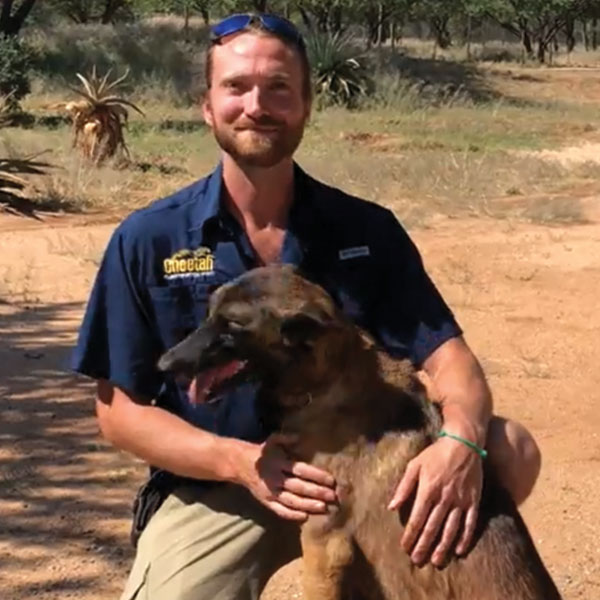Scat Detection Gobabis Project
-

- by Tim Hofmann February 3, 2022

This year the scat detection dog team conducted its first systematic survey to find cheetah scat across a large landscape. The aim was to draw conclusions about cheetah presence, their diet and the genetic structure, but also to quantify how much effort we need to invest to detect cheetahs. To find scat we walked 2 km sections on roads randomly chosen and tried to find the prominent marking sites where territorial males leave scat behind, the so called playtrees.

The study area is north of the town Gobabis on livestock farmland, the most important habitat type for cheetah in Namibia. In this area we believe cheetah numbers are higher than in other parts of the country, which is a great set up to trial our team in the field. In addition to scat detection, Stijn Verschueren, PhD student in our ecology department deployed camera traps at identified playtrees and road junctions to monitor the area over several seasons. The combination of scat detection and camera traps to study cheetahs is novel and we are very excited to see how well this approach performs compared to other survey methods.
In particular, because the combined research methodology has little to no impact on the cheetah’s biology and could work well to rapidly assess the population status of cheetahs in an understudied area. While this is a great opportunity from a scientific point of view, it is also nice to work closely together with our various departments and enjoy the field together.

Our scat dog Enya and I did multiple trips to the area adding up to some two months in the field. It was nice to be accompanied by Stijn and discuss our project in the field but also by many other enthusiastic staff like Mike and Petoorua and our ecology intern Dallas. We worked throughout the dry season which is most productive for us because scats are not eaten by dung beetles or washed away by the rain.
Additionally the moderate temperatures increase the daily working hours for the dog but also lead to surprisingly cold nights. On our first trips we were really not prepared for this and only the thought that it warms up again after sunrise eventually helped us a lot. It eventually got down to -9 °C and we had to warm up our frozen water in the morning to brush teeth.


Enya walked a total of 395 km on the 124 road transects and helped to find many carnivore scats but also indicated some potential cheetah scats. Some of those samples were under a tree that looked nothing like a playtree in our eyes, which is exciting as it shows us that we can find more cheetah scats when following Enya’s nose. Other scats were found randomly on transects and those might be of high value too as they could be from females or non-territorial males, which are difficult to find. Nevertheless most of the cheetah scats derived from playtrees, as usual. Some of the trees we checked were previously known by other surveys or the farmers but most trees were found by us. It is always special to find those marking sites of cheetahs, knowing that not long ago a cheetah or a whole group was here leaving their messages behind.
Fieldwork is always great, but with hard work. Nevertheless, just staying in nature the whole day is already worth it. We had countless animal encounters and met a lot of fantastic farmers that happily supported us by inviting us to their land to look for cheetah scat and we shared some very nice moments in the evening around the campfire.
After several months we are all very happy when the first rains slowly announced the end of the dry season which means that the second half of the year is about to start where I will spend more time at the computer working on the collected data but also planning the trips for next year.
Related Reading
-
December 4, 2024
Double Your Donation for the Cheetah -
June 15, 2024
Snake Aversion Training




